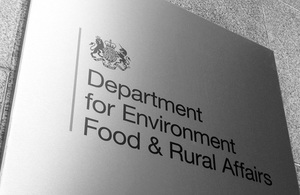Calls for crackdown after bird of prey poisoning maps are published
Nineteen incidents of illegal poisonings occurred in 2011 bringing the total number of confirmed cases since 2007 to 101.

Maps showing where birds of prey have been poisoned should serve as a wake-up call, Environment Minister Richard Benyon said today.
The maps, published for the first time by the Partnership for Action Against Wildlife Crime (PAW), highlight both the number and location of confirmed poisonings of birds of prey from 2007 to 2011 across England and Wales.
Nineteen incidents of illegal poisonings occurred in 2011 bringing the total number of confirmed cases since 2007 to 101.
Environment Minister Richard Benyon said:
I am appalled that these crimes continue to be committed and I am determined to stamp them out.
Those responsible have no consideration for what they are killing or the impact their activities are having on wildlife and the wider environment.
I want people to be alert to this problem and report their suspicions to the police. It is about time we put an end to this cruel and barbaric crime.
The information published today also shows that the majority of poisonings were carried out using substances called Carbofuran, or aldicarb, which are illegal to possess in the UK and are potentially dangerous to humans.
Members of the public are warned not to touch any suspected poisoned animals or baits and to report them to their local police by calling 101.
Bob Elliot, the RSPB’s head of investigations, said:
These maps are welcome as they illustrate the problem that our birds of prey face. We need to remember, however, that these dots represent the tip of a much bigger iceberg as these criminal offences are often discovered by pure chance.
These aren’t just points on a map. Each dot represents a crime where a bird of prey has been killed in a calculated way. Birds of prey have suffered centuries of persecution, and these maps prove those attitudes still prevail today. We will continue to work in partnership to ensure that we all bear down on these unacceptable crimes.
Glynn Evans, head of game and gamekeeping at the UK’s largest shooting organisation, the British Association for Shooting and Conservation (BASC) said:
The use of illegal poisons to kill birds of prey has no place in modern land and wildlife management. The British Association for Shooting and Conservation welcomes the publication of these incident maps which will be valuable tools in combating those who persist with this unacceptable practice.
Wales’ Environment Minister, John Griffiths, said:
I welcome the publication of these maps, which show the extent of this problem and focus attention on the illegal poisoning of birds of prey.
The Welsh Government is working with a number of organisations to send the message loud and clear that the illegal poisoning of wildlife is not acceptable and the law will be enforced.
The maps are available at www.defra.gov.uk/paw
Notes
These new charts show confirmed incidents of illegal poisoning. In 2011 there were 19 incidents, in which 30 birds of prey were poisoned.
The mapping project is an action supported by all members of the PAW England & Wales Raptor Persecution Priority Delivery Group which includes the Police, National Wildlife Crime Unit, BASC, Defra, the Moorland Association, Natural England, National Gamekeepers Organisation, Northern England Raptor Forum, RSPB and the Welsh Government.